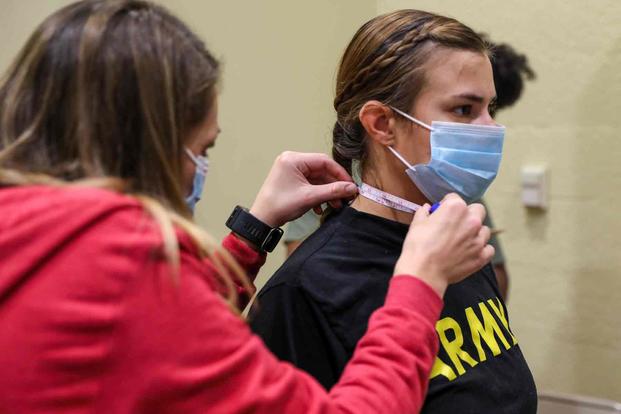The Army is planning to stick to how it currently measures body fat for soldiers after a massive research effort across the force found the so-called tape test accurate enough and alternative body scans to be far too expensive and impractical to issue to units service-wide.
There is a caveat: Soldiers might have a way to challenge initial results that find them too overweight to serve, a first for the Army.
For decades, the service has used what has largely been panned as outdated methods of measuring whether a soldier is out of fighting shape. That includes weighing them and measuring their neck and abdomen to calculate body fat percentage. The anxiety among the rank and file and key leaders parallels the decade-long struggle to create the service's new fitness test after the previous test was criticized for not adequately gauging fitness.
Read Next: Biggest Military Pay Raise in Decades Proposed by White House
"When I initially came in … I heard two questions: 'What are we doing about [the] Army Combat Fitness Test, followed by 'what are we doing about body composition?'" Sergeant Major of the Army Michael Grinston, the service's top enlisted leader, told reporters Wednesday, referencing the official name of the new fitness test, the ACFT.
A study of the force, which included 2,690 troops, found that the tape test is not a perfect science and roughly 35% of tape tests failed to accurately measure whether a soldier is in compliance with Army body fat standards.
Army planners and Congress have been increasingly concerned about fitness in the force, with the service and Capitol Hill going back and forth. Researchers for the service found that roughly 10% of soldiers are overweight, far below the general population, but a troubling figure, given the physical demands of military service.
Those researchers found that overweight soldiers are at least 50% more likely to suffer from injuries.
The tape test has generally been forgiving to soldiers. Only about 1% of soldiers are inaccurately found to be overweight, according to Army data reviewed by Military.com. But of that extreme minority of soldiers who are unfairly categorized as overweight, women are overrepresented.
A major component of that study was the service researching three different types of body scanners, which range in cost between $15,000 and $100,000. The scanners are standard methods of measuring body fat in the health care field and professional athletics. Army planners concede the machines are far more accurate than the tape test, but said they are too expensive to buy and be accessible to all soldiers at any given time, especially in the National Guard and reserve.
The research also showed those scans found that most soldiers have more body fat than detected by the tape test, sometimes as much as 8% more.
"I do call it the heartbreaker," Grinston said, referring to the body scanners. "I thought I was much leaner than I was. And I got on the [scanner], and it broke my heart. So I have a little bit more body fat than I really want."
Moving forward, Army planners are eyeing minor changes to the tape test, which are expected to boost accuracy by about 10%. That includes removing neck measurements and only measuring at the belly button, and minor shifts in calculating how that relates to a soldier's weight. Soldiers who are found to be out of compliance could be able to request to be scanned in one of the machines, though it's unclear how many the service plans to buy and how available they will be.
"We are proposing a way that you can actually get a second opinion before we separate soldiers," Grinston said. "I think that giving every chance and benefit of the doubt to soldiers is what we should be doing."
Those small adjustments to tape measuring and the ability to challenge results are still being finalized and are expected to become policy in the coming months.
The Army is also introducing a new policy this week that soldiers who score a 540 on the fitness test will not need to be taped and cannot be flagged for their weight. A score that high, out of a maximum 600, virtually guarantees a soldier is physically fit, demonstrating they can deadlift heavy weight and run quickly, among other physical challenges.
The tweaks to body fat composition could be among the last personnel changes during Grinston's tenure, which has become synonymous with overhauls to major pillars of training, including the implementation of the new fitness test; reintroducing land navigation back to noncommissioned officer academies; and setting the stage for a unique fitness test for the expert soldier, infantry and field medical badge tests.
Grinston, who is set to retire in August, told reporters that nutrition could be the next big thing the Army looks into, citing a proposed program in which soldiers could use meal cards at dining facilities or restaurants on base.
He says giving soldiers easy access to healthy food is key to performance and injury reduction. As of now, many Army dining facilities generally offer low-quality food, oftentimes having fattening food in abundance, though marginal changes have been made in recent years such as labeling how nutritious different foods are in hopes soldiers go with more lean and green options.
"This needs constant attention," Grinston said, referring to crafting policies impacting soldiers' physical health. "I'm not about taking things away. … If I want a pizza or cheeseburger, I want it. I don't want to stop selling Doritos at the Shoppette. But I want [soldiers] to make healthy life choices … and understand how [food] fuels the body."
-- Steve Beynon can be reached at Steve.Beynon@military.com. Follow him on Twitter @StevenBeynon.
Related: Army Zeroing In on New Ways to Measure Body Fat that Could Kill the Tape Test











